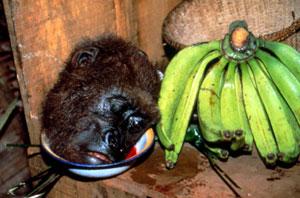
The finding that numbers of gorillas and chimpanzees appear to have dwindled twice as much near towns in Gabon than near villages supports a focus on conservation efforts that tackle commercial hunting over those that aim to convince villagers to give up subsistence hunting, says Hjalmar Kühl at the Max-Planck-Institute for Evolutionary Anthropology in Leipzig, Germany, who conducted the study with colleagues.
The team counted sleeping nests left by gorillas and chimps in Gabon's mountainous Moukalaba Doudou National Park. They found that nest density decreased the closer they got to the towns that surround the park. The towns' populations range from 10,000 to 18,000 people.
Although some nests could be found close to the towns, their overall density was only half that seen in the centre of the park. In contrast, the team found no such gradient near smaller villages.
"This suggests that the impact local subsistence hunting has is much smaller than that from commercial hunters coming from the bigger towns," says Kühl.
'Already rare'
The existence of organised bushmeat transport and trade cartels had suggested that town-based hunting is indeed commercial and caters for more than just the local people's needs, with primate meat reaching plates as far as North America.
"But until now we didn't know how drastically it was affecting the apes," says Kühl.
The problem with estimating the impact of ape hunting just from watching local markets and hunters, he explains, is that this reveals little about how the population may be suffering as a whole. "We rarely find ape meat in the markets, but these animals are already so rare and reproduce so slowly that even comparatively low-level hunting might do a lot of damage," he says.
The absence of chimp and gorilla nests near the towns now confirms what might be expected: that ape populations have already suffered from commercial hunting. Because the researchers did not find a similar depletion of nests near smaller villages, they also conclude that any ape meat that makes it to the urban areas is not brought and sold there by the villagers, but results from organised hunting trips from the towns people themselves.
'Major challenge'
"This fits in with what we know from case studies about commercial hunting. It tends to be organised by relatively wealthy people who already have access to the necessary vehicles and funds," says Kühl. As a result, he argues, future conservation efforts should focus on restricting and monitoring transport into and out of the park. Initiatives to provide local villagers with alternatives to subsistence hunting should not be abandoned but "are less crucial", he says.
"There is still a lot of debate on how to stop the trade into urban centres," says Marcus Rowcliffe, an expert in the bushmeat trade at the Institute of Zoology in London, UK. "Effective control systems are going to depend on government capacities to enforce law and fight corruption," he says, "and that is going to be a major challenge."
Journal reference: Journal of Biological Conservation (DOI: link)



Reader Comments
to our Newsletter